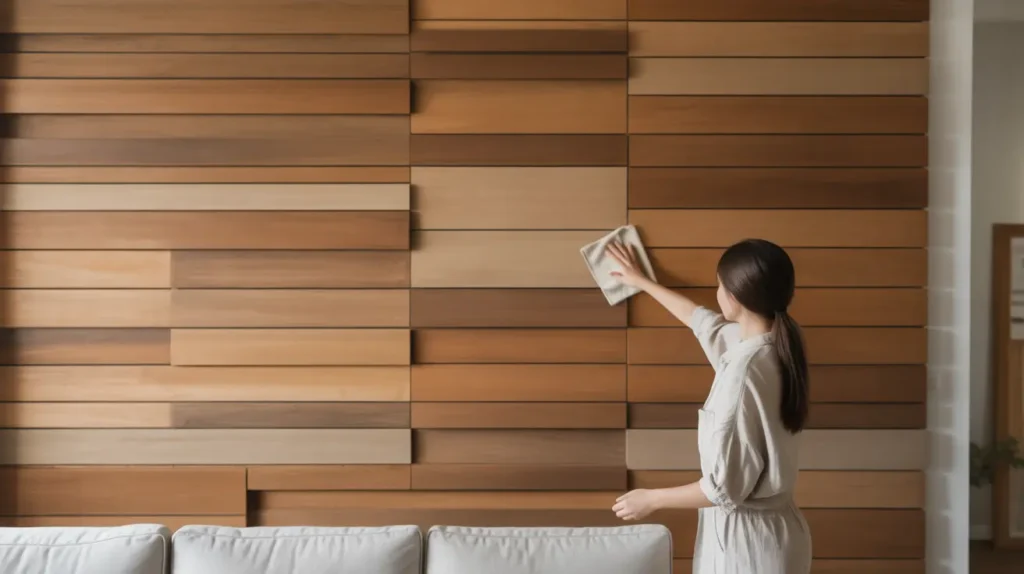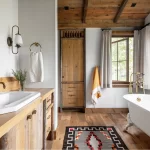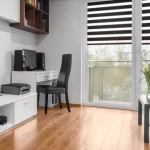Wood walls are more than simple structural elements—they add warmth, texture, and character to any room. Over the years, I’ve explored different wood wall design ideas in living rooms, bedrooms, and home offices, and each transformation has been remarkable. A carefully chosen wooden accent wall can instantly uplift a space, reflecting both style and personality.
In this blog, we’ll share creative ideas ranging from rustic charm to modern minimalism. Whether you’re planning a DIY project or professional installation, these tips and examples will help you bring timeless elegance to your interiors.

Content
Why Wood Wall Design Matters
Wood walls are versatile and functional. They don’t just enhance a room’s aesthetic—they also influence mood, improve acoustics, and add warmth that paint alone can’t achieve. Using natural textures and tones can make small rooms feel cozier and larger spaces more inviting.
For example, a well-designed wood wall design paired with neutral furniture adds depth and sophistication, while 3D wooden panels create a striking focal point that draws the eye.
How to Choose the Right Wood Wall Design
Selecting the right wood wall design depends on several factors:
- Room Purpose: Soft wooden tones work beautifully in bedrooms, while bold textures energize living or entertainment areas.
- Lighting: Light-reflective panels can brighten darker spaces, while darker woods create a cozy, intimate atmosphere.
- Style Preference: From rustic reclaimed wood to sleek modern slats, pick a style that complements your interior décor.
- Budget: DIY-friendly options like peel-and-stick wood panels or plywood can achieve premium looks without breaking the bank.
Pro Tip: Test samples on small sections of your wall first. Wood tones can look very different under natural light versus artificial lighting.
Top Wood Wall Design Ideas
Here are some of the most inspiring wood wall design ideas to consider for your home:
1. Wooden Accent Wall Panels
A simple accent wall using wood panels adds warmth and elegance. Choose horizontal or vertical panels depending on whether you want to make the room feel wider or taller.
2. Slat Wall Panels for Modern Elegance
Slat walls are sleek, minimalistic, and perfect for modern interiors. They also improve room acoustics, making them ideal for home offices and living rooms.
3. Reclaimed Wood Panels
Eco-friendly and full of character, reclaimed wood panels bring rustic charm to any space. They pair beautifully with industrial or farmhouse décor.
4. 3D Wooden Wall Panels
3D panels offer texture and depth, transforming a flat wall into a statement piece. From geometric patterns to abstract designs, these panels are versatile and visually striking.
5. Wood Veneer Panels

Wood veneer panels are thinner and more cost-effective than solid wood but provide a similar aesthetic. They’re great for creating large feature walls without heavy installation.
6. DIY Wood Wall Panel Ideas
For DIY enthusiasts, peel-and-stick panels, natural wood slats, or painted wood planks can create stunning effects. It’s a fun and cost-effective way to personalize your space while adding warmth and character.
7. Tree of Life or Mural-Inspired Wooden Walls
Mural designs carved or painted on wood add artistic flair. A tree of life mural in the living room, for example, can become a conversation starter while bringing a natural element indoors.
8. Herringbone and Chevron Patterns
Arranging wood panels in a herringbone or chevron pattern creates visual interest and sophistication. These patterns work well behind beds or TV units.
9. Combination of Wood and Paint
Mixing wood panels with painted sections lets you highlight features and add color contrast. For example, a half-paneled wall with a complementary color above can balance texture and tone.
Real-Life Case Study: Living Room Transformation
A client in Karachi wanted to refresh their living room with a modern yet cozy feel. They had a plain white wall behind the sofa that felt cold and uninviting. After exploring several wood wall design ideas, we decided on a reclaimed wood accent wall combined with vertical slat panels.
The transformation was remarkable: the room felt warmer, visually dynamic, and more inviting for family gatherings. The client also added LED strip lighting along the slats, which highlighted the texture and created a modern aesthetic. This project demonstrated how thoughtful design choices can transform a space without major renovations.
Maintenance Tips for Wood Walls

To keep your wooden walls looking fresh:
- Dust or wipe regularly with a soft, dry cloth.
- Avoid excessive moisture to prevent warping.
- Use protective finishes on reclaimed or raw wood panels.
- Repair or touch up scratches promptly to maintain a uniform look.
Final Thoughts
Wood walls are a timeless addition to any interior. From modern wood wall design for living rooms to DIY wood wall panel ideas, the possibilities are endless. Whether you choose textured 3D panels, reclaimed wood, or mural-inspired designs, the key is to balance aesthetics with functionality.
Experiment with patterns, colors, and finishes to create a space that is uniquely yours. With careful planning and creativity, your walls can become more than just a backdrop—they can tell your story and elevate your home’s overall ambiance. For more information visit our website home-decoration-ideas.com
FAQ’s:
What is the wood design on a wall called?
A wall made of wood panels is often called a wooden accent wall or wood wall design, depending on style and installation.
What kind of wood for wall design?
Common choices include reclaimed wood, oak, walnut, and veneer panels, each offering unique texture, tone, and durability.
What are the latest trends in wood walls?
Modern trends feature 3D wooden wall panels, slat walls, herringbone or chevron patterns, and mixed wood-and-paint designs.
What are the benefits of wooden walls?
Wood walls add warmth, texture, and depth, improve acoustics, enhance aesthetics, and can increase a room’s perceived value.

Amber is a home blogger who loves to share her experiences with others. She likes being motivated and encourages people to be the best they can be.









